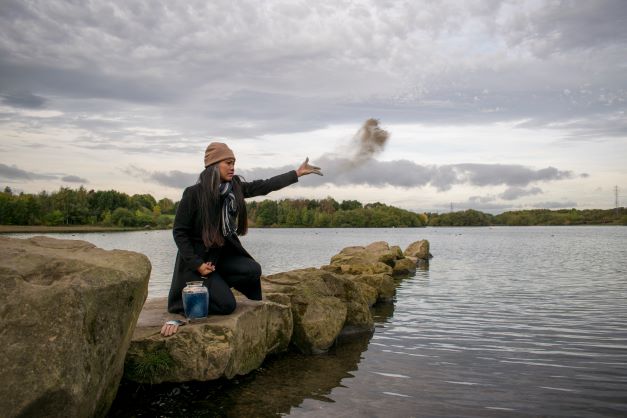All Articles & Guides / Ashes / The Best Tips for Scattering Ashes at Sea
The Best Tips for Scattering Ashes at Sea
With rising cremation rates in the United States, more and more people are interested in scattering their loved one’s ashes as a meaningful way to honor their memory. For many families, scattering ashes at sea or in a lake can represent a release from earthly concerns, a return to nature, and/or commemorate the love that the individual had for the ocean or a particular location. There are a few issues that may arise if you’re planning on scattering ashes at sea or on a body of water, a little bit of planning can make the process go more smoothly.

Know Your Local Water Laws
Scattering ashes at sea is legal, but there are some laws you’ll need to abide by. Here are the three main rules from the U.S. EPA you need to be aware of:
- You can’t scatter ashes at sea within 3 nautical miles of shore.
- You can’t dispose of your pet’s remains in the sea.
- You must use a biodegradable material if remains are enclosed in an object.
- You must request a MPRSA permit.
The Environmental Protection Agency is responsible for regulating what is put into territorial waters, which extend at least 12 nautical miles (14 miles) from the baseline or low water mark of the land. Waters up to 3 miles from the low water mark are typically regulated by individual states, however. Lakes, ponds, rivers, and other bodies of water within the United States are typically (although not always) regulated by the state or local governments.
This is important because you need to know what the law is regarding scattering ashes in a body of water within a particular location. The EPA allows for ashes to be scattered at sea past the 3-mile mark without a permit, with some restrictions. You cannot put anything into the water that will not break down quickly (in other words, no plastic or metal objects), for example. You also cannot scatter pet cremains without getting prior permission first.
Within 3 miles of the coastline, however, the rules for scattering ashes at sea can vary by state. Most states do not allow ashes to be spread on the beach, but you may be permitted to spread them 500 yards or more from shore. If you want to spread the ashes in a lake or pond, you’ll need to check with local authorities to find out if they have any specific regulations that you need to follow.
Biodegradable Urns for Water Burial
No matter where you are scattering ashes at sea, make sure that you’re not polluting the water with objects that won’t break down. There are many biodegradable cremation urns available that will break down over time when exposed to water. If you have an urn that’s made of metal or ceramic, you’ll need to scatter the ashes directly into the water and take the urn back to shore with you. Spreading flowers or floating lanterns on the water can be beautiful, but make sure that there are no parts made of metal, plastic, or other similar materials. Any wreath should not contain wire fasteners, for example, which could harm fish or be left to clutter up the area. Don’t put anything in the water that could be swallowed or otherwise injure marine wildlife. Anything that you put into the water should either disintegrate relatively quickly or it needs to be removed before you leave.

Planning a Scattering Ashes at Sea Ceremony
In order to prepare for this type of ceremony, you’ll need to take into consideration a few factors.
- Transportation – If you’re planning on scattering ashes at sea, you’ll need a boat to carry you at least 3 nautical miles from shores. You can search for water burial services in your desired location to organize transportation out to sea. You’ll also need to ask whether the service includes pulling a MPRSA permit and can provide the necessary GPS coordinates. Keep in mind how many individuals will be attending the ceremony when deciding on boat. Make sure to discuss any special requests with your charter company beforehand to make sure they can accommodate your plans. Rather than traveling by boat, some people choose to have cremated remains buried at sea from an airplane. It’s best to hire a professional service with experience scattering ashes, because it can be challenging to release the cremains with the wind conditions experienced during flight.
- Weather – One of the most common horror stories told of scattering ashes at sea is the family opening the urn to spread the ashes, only to have them blown back by the wind onto the guests. It can get very windy on the ocean or even on a lake, and it’s often difficult to predict exactly which direction the wind will come from. It’s a good idea to bring some type of device that indicates the wind direction, even if it’s a piece of ribbon attached to a long stick. Take your time to see if you can determine a general wind direction and wait for the wind to calm, if possible. Everyone should stand upwind as much as they can, so that the cremains will blow away from people and the boat. It’s also a good idea to release the ashes close to the water, if possible, so they are less likely to get caught by the wind. Be aware, however, that it’s very difficult to prevent any blowback. Keep an eye out for rain or storms as well. The cremains may clump together more on a very humid day, making them more difficult to scatter. You may also face other difficulties, such as rough waves and high winds, which could make the experience more difficult.
- Check the Condition of Cremains – Before you set off to scatter ashes at sea, open the cremation urn and check the condition of the cremains. Cremains can settle over time, and you’ll want to make sure that they have not clumped together. If you find that they are not loose enough to scatter, use a spoon or other object and gently break apart any clumps. Make sure the urn is easy to open, but has a tight seal so an accidental spillage doesn’t occur. Keep in mind the remains may be inside a plastic bag and that you may need scissors to open the bag as well.
- Be Prepared for the Journey – When traveling by boat or plane, it’s important that you dress appropriately and be prepared for an unsteady trip. Boat decks can get slippery, so attendees should wear appropriate no-slip footwear and keep in mind it’s often colder and windier at sea so make sure to bring plenty of layers. If you or your attendees are prone to seasickness, take the appropriate medication beforehand. If children are going to attend the ceremony, make sure that they are carefully monitored and that you take the right precautions to prevent any accidents at sea.

Scattering Ashes at Sea Ceremony Ideas
There are many ways to scatter ashes at sea without just flinging them into the breeze or pouring them in the water off the side of a boat. First, you can choose between a private unattended service or an attended service.
An unattended service is a good solution for families or individuals who are unable to attend. In this scenario you can send the ashes to the company that will be performing the service and the captain of the ship will scatter your ashes along the seaward journey. They can also sign and provide you a certificate with the GPS coordinates of the scattering. They’re often open to your requests for music, poems, or excerpts to be read while performing the service.
Attended services may require some further planning and can be similar to land-based services. You can plan to have speeches, poems, prayers, and music played during the event.
If your deceased loved one had close ties with the sea, you can opt for a mariner’s farewell ceremony. As you are scattering ashes at sea, the mariner’s farewell verse is read and the ship’s bell tolls eight times. Attendees can each toss a flower into the water as a final farewell.
A more adventurous method is to have a sunset ceremony with mourners in small kayaks, canoes, or boats. As they form a circle the ashes are then poured from a boat into the center.
A night time ceremony can also be performed with flower wreaths or biodegradable lanterns. Your loved one’s ashes can be placed into a biodegradeable urn and pushed out to sea as the sun is setting and night falls. You can also consider a sea burial if you don’t plan on releasing ashes.
A beach side service may be preferable for those that aren’t convinced that they should go 3 nautical miles out to sea. This may depend on your location, and you’ll have to make sure you abide by EPA regulations, which means you won’t actually be able to scatter cremated remains on the beach.
If you’re considering scattering ashes within inland bodies of water such as rivers or lakes, you will be required to obtain a permit from the state agency that manages that body of water. The Clean Water Act governs scattering ashes in inland locations and it’s best to reach out to your local regulation agency to ensure you’re following the correct rules.
Scattering ashes at sea is an incredible way to say goodbye to a loved one and cherish your final moments before returning your loved one to nature. We offer this guide to help you plan a beautiful send-off while following guidelines and knowing what to expect.
Related Content





